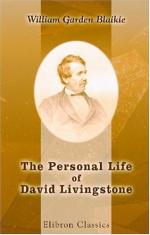On coming among his old friends the Makololo, he found them in low spirits owing to protracted drought, and Sekeletu was ill of leprosy. He was in the hands of a native doctress, who was persuaded to suspend her treatment, and the lunar caustic applied by Drs. Livingstone and Kirk had excellent effects[60]. On going to Linyanti, Dr. Livingstone found the wagon and other articles which he had left there in 1853, safe and sound, except from the effects of weather and the white ants. The expressions of kindness and confidence toward him on the part of the natives greatly touched him. The people were much disappointed at not seeing Mrs. Livingstone and the children. But this confidence was the result of his way of dealing with them. “It ought never to be forgotten that influence among the heathen can be acquired only by patient continuance in well-doing, and that good manners are as necessary among barbarians as among the civilized.” The Makololo were the most interesting tribe that Dr. Livingstone had ever seen. While now with them he was unwearied in his efforts for their spiritual good. In his Journal we find these entries:
[Footnote 60: In 1864, while residing at Newstead Abbey, and writing his book, The Zambesi and its Tributaries, Dr. Livingstone heard of the death of Sekeletu.]
“September 2, 1860.—On Sunday evening went over to the people, giving a general summary of Christian faith by the life of Christ. Asked them to speak about it afterward. Replied that these things were above them—they could not answer me. I said if I spoke of camels and buffaloes tamed, they understood, though they had never seen them; why not perceive the story of Christ, the witnesses to which refused to deny it, though killed for maintaining it? Went on to speak of the resurrection. All were listening eagerly to the statements about this, especially when they heard that they, too, must rise and be judged. Lerimo said, ’This I won’t believe.’ ‘Well, the guilt lies between you and Jesus,’ This always arrests attention. Spoke of blood shed by them; the conversation continued till they said, ’It was time for me to cross, for the river was dangerous at night.’”
“September
9.—Spoke to the people on the north side
of
the river—wind
prevented evening service on the south.”
The last subject on which he preached before leaving them on this occasion was the great resurrection. They told him they could not believe a reunion of the particles of the body possible. Dr. Livingstone gave them in reply a chemical illustration, and then referred to the authority of the Book that taught them the doctrine. And the poor people were more willing to give in to the authority of the Book than to the chemical illustration!




